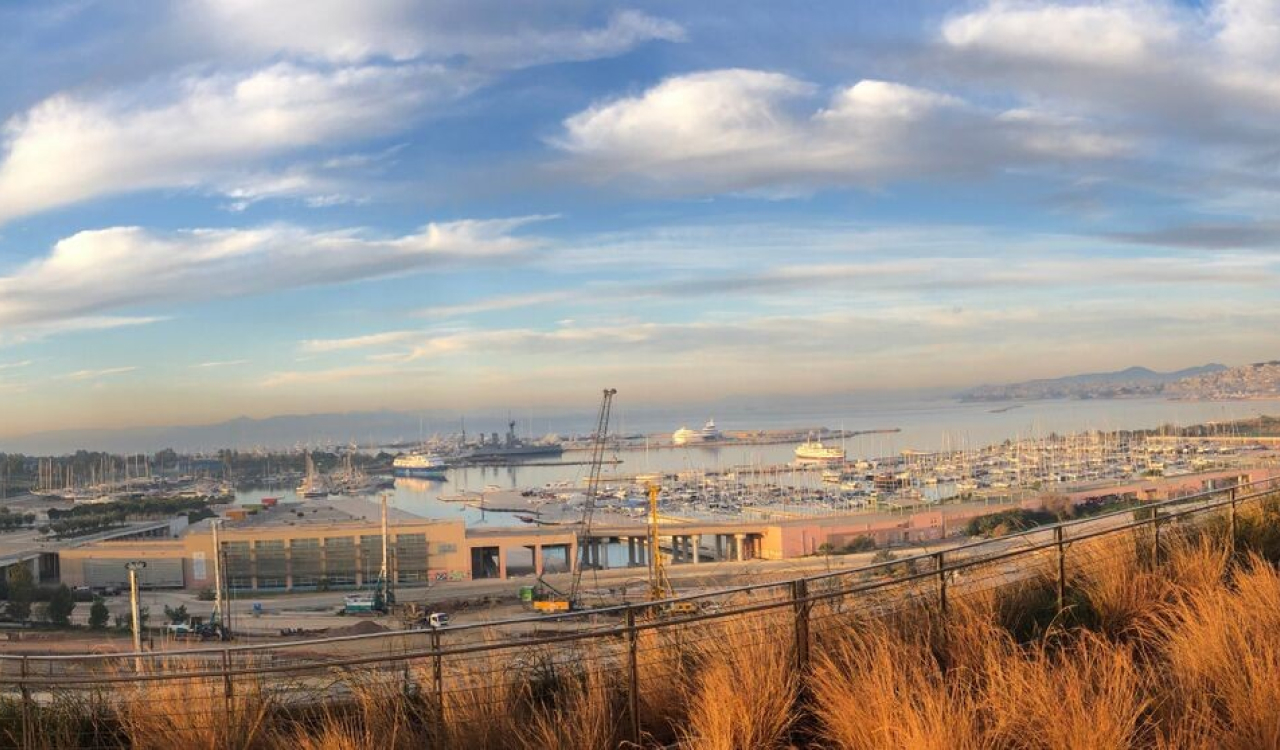ATHENS, Greece — It’s January, the sky is blue with clouds slowly creeping across from east to west — there is a chill in the air, but I can also see the light blue/pink tinge of colour on the Aegean skyline.
Standing on the mezzanine of The Stavros Niarchos Cultural Centre in southern Athens — designed by renowned architect Renzo Piano (Pompidou Centre Paris, Whitney Museum of American Art New York, The Shard London).
A profound building in a profound city.
Looking across the Saronic Gulf towards the horizon (doing my best to seem like I know all about architecture, ancient Athens and the maritime world) I feel a long way from home, yet at the same time, tethered to my ancestors.
As I admire the marina, the sea and the salt-water spray in the air, Dimitris Lekkas, founder of MarineTraffic who is standing next to me, says “I love how this iconic building slowly drifts out into the water. Somebody thought of that.”
Dimitri founded MarineTraffic in his home, eleven years ago — now a global leader in ship-tracking and maritime intelligence, with offices in six international locations (Athens, Oxford, Majorca, Singapore and the Philippines) the company celebrates thousands of customers and is fast becoming the world’s digital maritime hub.
Affectionately known as “DL” (there are six other people in the company with the name Dimitri, and today, that includes me) — Dimitri L. exhales and I know he’s longing to be out there.
On the water.
This simple comment and the gaze towards that beautiful winter-blue-pink horizon, I decide is the key to teaching the 100+ people about innovation — and if they don’t see the simplicity and complexity of this statement, they’ll struggle.
If they do, they'll thrive.
I walk into the auditorium and I welcome the participants who are here to attend my full-day workshop on innovation culture — a key part of Tank’s 12-week Innovation Culture Program.
Working with a very talented group of leaders at MarineTraffic, I am lucky to have their encouragement as the familiar din of the beginning of a workshop starts to sound. Having facilitated large groups such as this before, I’m familiar with the pensive, “who the hell is this guy?” look on people’s faces — the “here we go again” sense in the air and the smell of “jargon is about to happen.”
I smile as I see 110 capable, smart and intelligent adults from around the world huddled around circular tables like school children. I ask them to rearrange the room to make themselves comfortable, and while they do so, to take in the view — they all smile and roar in appreciation as they turn the large, glass-filled conference room into something that would resemble the jungle of Where The Wild Things Are, if Tech Entrepreneurs took it over.
Our workshop covers everything from the mindset of high-performance teams, through to practical and rapid ideation, prototyping and pitching sessions. From empathy, to the context of the emerging opportunities that are rising in the global shipping industry.
The day is a joy and I walk away learning quite a few new things about innovation myself, if not having made a few new friends.
Walking to my apartment in central Athens (please allow me this sentence, as I’ve always wanted to say this...) I begin to think about the obstacles the leadership team will have in the weeks, days and months to follow.
The hurdles they'll need to jump and the opportunities they'll need capture.
The goal of creating an innovation culture hasn't just ended for them — it's only just begun.
I stop to capture my thoughts and write down a list of obstacles and opportunities that any organisation faces in creating a culture of innovation:
Aligning culture with values
Culture is an intangible aspect of an organisation, created from the combination of behaviours, rituals and rhythms which leadership creates and allows to occur.
Drawing a line in the sand and defining what a high-performing team values, dictates how that team performs and behaves.
Aligning an innovation mindset with culture and values — intertwining it — is critical. Then comes behaviour, rituals and rhythms. Another story all together.
The inability to drop our guard
We all begin with the apprehension that what we are about to learn is something we’ve already heard before. Something that won’t truly entertain or delight — or something that is simply jargon wrapped in a different kind of wrapping paper. We begin most interactions, with our guards up — and most people, in most organisations wear a mask that prohibits true, authentic collaboration to occur.
Learning to dropping our guard is critical to high performance and the mindful practice of good, open-hearted leadership.
The inability to see simplicity
Dimitris mentioned something simple to me — so simple and profound that sits at the core of innovation within his organisation and innovation more broadly.
The ability to see simplicity amongst complexity.
When designing The Stavros Niarchos Cultural Centre in Athens, Architect Renzo Piano did something that most of us fail to do in our fast-paced, hustle-too-fast lives. He paused to observe, reflect and create something simple, with impact.
As Mr. Lekkas said to me on the mezzanine of a building which was funded by one of Greece’s most celebrated shipping magnates — the architect allowed the building to slowly drift out onto the water — whilst every other line points to one of the most iconic buildings of antiquity, and the modern world.
The Parthenon — seven kilometres away.
With a simple stroke, he connected the ocean, the legacy of a global shipping magnate with antiquity.
Simple, yet profound.
Innovation can be as simple as taking out a clean sheet of paper, observing our environment with some time to pause and reflect and then, calmly, drawing a few lines. Failing to allow for simplicity — or the time to pause and reflect — stifles creativity and the ability for teams to innovate.
The discipline of innovation
Many see innovation as a series of steps to be learned and followed. Codified creativity (HCD, Design Thinking) and the mishandling of it have much to answer for.
In truth, it can be as simple as Renzo Piano’s clean sheet of paper, or as messy as a room whose walls are covered with ideas.
Innovation is a discipline to be practiced and honed.
It is a company-wide imperative that doesn’t belong in ‘labs’ but in every position description — ultimately focussed on efficiency, sustainability and disruption. Three factors which can be used as lenses by any department, within any organisation.
Seeing collaboration as a replacement for accountability
In many an innovation circle we hear the word ‘collaboration’ — and many people see this as an opportunity to work and create together without fear of failure.
True.
But another truth is that innovative organisations are intolerant of incompetence, setting high performance standards for employees and driven to recruiting the best talent they can. Harvard Business Review says, “Exploring risky ideas that ultimately fail is fine, but mediocre technical skills, sloppy thinking, bad work habits, and poor management are not.”
A keen focus on today's value innovations with a keen eye on tomorrow's
MarineTraffic have successfully built a thriving business with over 1.2 Million customers — something is working very well.
So why innovate?
Innovation isn't about ping pong tables and free lunches — when organisations seek to increasingly deliver quantum leaps in value for customers, employees and shareholders alike — they begin to create an uncontested market space where true innovations takes place.
These value innovations align culture, a return to shareholders, employee and customer value, technological advancements and the three key aspects of innovation itself:
Efficiency.
Sustainability.
Disruption.
—
Learn more about The Innovation Culture Program.


